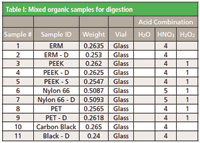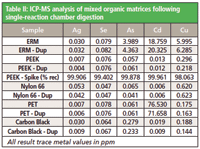Single Reaction Chamber Microwave Digestion of Highly Organic Matrices
Application Notebook
Sample matrices with high organic content have created a significant challenge for sample preparation methods.
Sample matrices with high organic content have created a significant challenge for sample preparation methods. Several techniques that have been used to obtain high quality multi-element ICP-OES/ICP-MS data for trace metals analysis, including microwave digestion or a combination of high temperature ashing with digestion, do not provide a solution for all samples. Samples with high organic content, such as polymers, plastics, solvents, petroleum products, and some nutraceutical supplements present additional challenges for the conventional microwave digestion approach, with temperatures and pressures generated during the acid digestion step that are often out of range for traditional vessels. Additionally, a second limitation involves the inability to process multiple sample types or different acid combinations simultaneously.

Table I: Mixed organic samples for digestion
Results and Data
Single reaction chamber (SRC) technology has recently been described as a technique with the capability of digesting several different sample types simultaneously, including difficult catalysts and highly organic samples. Milestone's UltraWAVE microwave digestion system was used to digest a number of highly organic polymer matrices in disposable glass vials simultaneously, which has been shown to generate pressures exceeding those of conventional closed vessels. The program selected used a 15 min ramp to 160 °C, and then 15 min to 260 °C, followed by a 15 min hold time at 260 °C. Following digestion, the samples were concentrated to a volume of 1 mL, then diluted to 10 mL with deionized water and analyzed on an Agilent 7700 ICP-MS in Helium mode.

Table II: ICP-MS analysis of mixed organic matrices following single-reaction chamber digestion
Conclusion
The UltraWAVE is able to digest a number of difficult organic samples simultaneously, enabling independent sample types to be processed in a single operation. Both the design and capability allow difficult organic samples to be processed without time spent on method development work on a per sample basis.

Milestone, Inc.
25 Controls Drive, Shelton, CT 06484
tel. (866) 995-5100, fax (203) 925-4241
Website: www.milestonesci.com

Newsletter
Get essential updates on the latest spectroscopy technologies, regulatory standards, and best practices—subscribe today to Spectroscopy.
Specificity and the Net Analyte Signal in Full-Spectrum Analysis
July 21st 2025This tutorial addresses the critical issue of analyte specificity in multivariate spectroscopy using the concept of Net Analyte Signal (NAS). NAS allows chemometricians to isolate the portion of the signal that is unique to the analyte of interest, thereby enhancing model interpretability and robustness in the presence of interfering species. While this tutorial introduces the foundational concepts for beginners, it also includes selected advanced topics to bridge toward expert-level applications and future research. The tutorial covers the mathematical foundation of NAS, its application in regression models like partial least squares (PLS), and emerging methods to optimize specificity and variable selection. Applications in pharmaceuticals, clinical diagnostics, and industrial process control are also discussed.
New Study Expands Nickel Autoionization Spectra to Advance Laser Isotope Separation Technologies
July 17th 2025Researchers at China’s National Key Laboratory have identified 170 nickel autoionization states using resonance ionization mass spectrometry, significantly advancing the spectral database critical for laser isotope separation and atomic spectroscopy.
AI-Powered Fusion Model Improves Detection of Microplastics in the Atmosphere
July 17th 2025Researchers from Nanjing University of Information Science & Technology have introduced a breakthrough AI-enhanced multimodal strategy for real-time detection of polyamide microplastics contaminated with heavy metals.
How Analytical Chemists Are Navigating DOGE-Driven Funding Cuts
July 14th 2025DOGE-related federal funding cuts have sharply reduced salaries, lab budgets, and graduate support in academia. Researchers view the politically driven shifts in priorities as part of recurring systemic issues in U.S. science funding during administrative transitions. The impact on Federal laboratories has varied, with some seeing immediate effects and others experiencing more gradual effects. In general, there is rising uncertainty over future appropriations. Sustainable recovery may require structural reforms, leaner administration, and stronger industry-academia collaboration. New commentary underscores similar challenges, noting scaled-back graduate admissions, spending freezes, and a pervasive sense of overwhelming stress among faculty, students, and staff. This article addresses these issues for the analytical chemistry community.